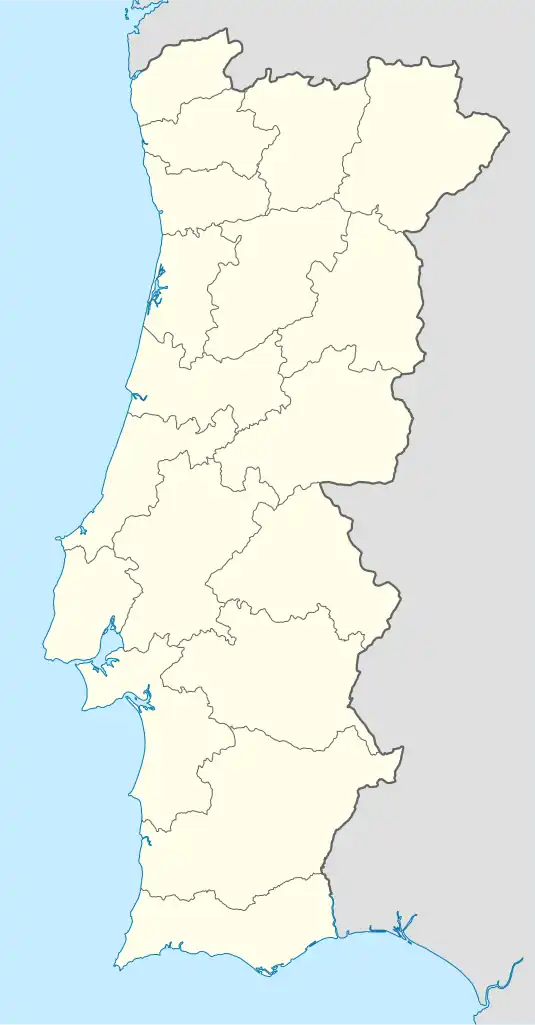Favaios
Favaios (Portuguese pronunciation: [fɐˈvajuʃ]) is a civil parish of the municipality of Alijó, in northern Portugal. The population in 2011 was 1,064,[1] in an area of 21.45 km2.[2] The region is known for its wines, namely, the moscatels like Moscatel de Favaios.
Favaios | |
|---|---|
 | |
 Favaios Location in Portugal | |
| Coordinates: 41.267°N 7.499°W | |
| Country | |
| Region | Norte |
| Intermunic. comm. | Douro |
| District | Vila Real |
| Municipality | Alijó |
| Area | |
| • Total | 21.45 km2 (8.28 sq mi) |
| Elevation | 498 m (1,634 ft) |
| Population (2011) | |
| • Total | 1,064 |
| • Density | 50/km2 (130/sq mi) |
| Time zone | UTC±00:00 (WET) |
| • Summer (DST) | UTC+01:00 (WEST) |
| Postal code | 5070 |
| Area code | 259 |
| Website | https://web.archive.org/web/20110816182334/http://freguesiadefavaios.com/ |
History
Favaios was occupied by Roman legions between 218 BCE and 201 BCE, who took it from the tribes of Lusitanians and Hispanic clans.[3] The founders came from the families and relations of the Flavian dynasty, of Imperial Rome, who rose to prominence after Emperor Titus Flavius Caesar Vespasianus Augustus.[3] The parish's name is derived from Flávios, a corruption of the original name of this leader, Flavius .[3] Roman Flávios belonged to a vast territory known as Panoias (not to be confused with modern-day Panoias which is a small community in the municipality of Braga). Ancient Panoias extended from the river Marão to the Tua River, and from the Douro River to the current site of Murça.[3]
The invasion of the Iberian peninsula by Arabs reached the north, where the Moors took the Roman Castle of Flávias: it would later be remembered as the "Castelo dos Mouros” (English: Castle of Moors). This occupation forced the locals to escape the region and re-established settlements away from Favaios: half the population took refuge in the area that would be renamed São Bento.[3] From this new colony the Portuguese battled the Moors of Favaios; after the expulsion of the Moors the region was covered in the destruction of these battles.[3] The destruction lead to a slow reconstruction of Favaios.
Favaios received in 1211 its Carta de Alforria (Charter of liberty/freedom) from King Afonso II, and its foral (charter) in 1270 by Afonso III (which was later confirmed in 1284 by King Denis).[3] Strangely, during the reign of Manuel I the charter was revoked in 1514, to be reinstituted the following year, ordering that the local fountain be marked with the Royal shield over an armillary sphere, surmounted by a crown.[3]
Geography
With an area of 21.45 km2, Favaios is located along a plateau in the Trás-os-Montes e Alto Douro[3] province, district headed by Vila Real de Trás-os-Montes city.
References
- Instituto Nacional de Estatística (INE), Census 2011 results according to the 2013 administrative division of Portugal
- "Áreas das freguesias, concelhos, distritos e país". Archived from the original on 2018-11-05. Retrieved 2018-11-05.
- Paredes, Daniel; Pinto, André (2010). Junta Freguesia (ed.). "Descobrir o Passado" (in Portuguese). Favaios (Alijó), Portugal: Junta de Freguesia de Favaios. Archived from the original on 16 August 2011. Retrieved 6 June 2011.